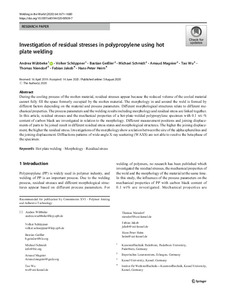Datum
2020-08-05Autor
Wübbeke, AndreaSchöppner, VolkerGeißler, BastianSchmidt, MichaelMagnier, ArnaudWu, TaoNiendorf, ThomasJakob, Fabian SimonHeim, Hans-PeterSchlagwort
600 Technik 670 Industrielle Fertigung HeizelementschweißenGefüge <Werkstoffkunde>EigenspannungAbkühlungMetadata
Zur Langanzeige
Aufsatz

Investigation of residual stresses in polypropylene using hot plate welding
Zusammenfassung
During the cooling process of the molten material, residual stresses appear because the reduced volume of the cooled material cannot fully fill the space formerly occupied by the molten material. The morphology in and around the weld is formed by different factors depending on the material and process parameters. Different morphological structures relate to different mechanical properties. The process parameters and the welding results including morphology and residual stress are linked together. In this article, residual stresses and the mechanical properties of a hot-plate-welded polypropylene specimen with 0.1 wt.-% content of carbon black are investigated in relation to the morphology. Different measurement positions and joining displacements of parts to be joined result in different residual stress states and morphological structures. The higher the joining displacement, the higher the residual stress. Investigations of the morphology show a relation between the size of the alpha spherulites and the joining displacement. Diffractions patterns of wide-angle X-ray scattering (WAXS) are not able to resolve the beta phase of the specimen.
Zitierform
In: Welding in the World Volume 64 / Issue 10 (2020-08-05) , S. 1671-1680 ; EISSN 1878-6669Zusätzliche Informationen
Gefördert im Rahmen des Projekts DEALZitieren
@article{doi:10.17170/kobra-202011052086,
author={Wübbeke, Andrea and Schöppner, Volker and Geißler, Bastian and Schmidt, Michael and Magnier, Arnaud and Wu, Tao and Niendorf, Thomas and Jakob, Fabian Simon and Heim, Hans-Peter},
title={Investigation of residual stresses in polypropylene using hot plate welding},
journal={Welding in the World},
year={2020}
}
0500 Oax
0501 Text $btxt$2rdacontent
0502 Computermedien $bc$2rdacarrier
1100 2020$n2020
1500 1/eng
2050 ##0##http://hdl.handle.net/123456789/11990
3000 Wübbeke, Andrea
3010 Schöppner, Volker
3010 Geißler, Bastian
3010 Schmidt, Michael
3010 Magnier, Arnaud
3010 Wu, Tao
3010 Niendorf, Thomas
3010 Jakob, Fabian Simon
3010 Heim, Hans-Peter
4000 Investigation of residual stresses in polypropylene using hot plate welding / Wübbeke, Andrea
4030
4060 Online-Ressource
4085 ##0##=u http://nbn-resolving.de/http://hdl.handle.net/123456789/11990=x R
4204 \$dAufsatz
4170
5550 {{Heizelementschweißen}}
5550 {{Gefüge <Werkstoffkunde>}}
5550 {{Eigenspannung}}
5550 {{Abkühlung}}
7136 ##0##http://hdl.handle.net/123456789/11990
<resource xsi:schemaLocation="http://datacite.org/schema/kernel-2.2 http://schema.datacite.org/meta/kernel-2.2/metadata.xsd"> 2020-11-17T15:15:13Z 2020-11-17T15:15:13Z 2020-08-05 doi:10.17170/kobra-202011052086 http://hdl.handle.net/123456789/11990 Gefördert im Rahmen des Projekts DEAL eng Namensnennung 4.0 International http://creativecommons.org/licenses/by/4.0/ hot plate welding morphology residual stress 600 670 Investigation of residual stresses in polypropylene using hot plate welding Aufsatz During the cooling process of the molten material, residual stresses appear because the reduced volume of the cooled material cannot fully fill the space formerly occupied by the molten material. The morphology in and around the weld is formed by different factors depending on the material and process parameters. Different morphological structures relate to different mechanical properties. The process parameters and the welding results including morphology and residual stress are linked together. In this article, residual stresses and the mechanical properties of a hot-plate-welded polypropylene specimen with 0.1 wt.-% content of carbon black are investigated in relation to the morphology. Different measurement positions and joining displacements of parts to be joined result in different residual stress states and morphological structures. The higher the joining displacement, the higher the residual stress. Investigations of the morphology show a relation between the size of the alpha spherulites and the joining displacement. Diffractions patterns of wide-angle X-ray scattering (WAXS) are not able to resolve the beta phase of the specimen. open access Wübbeke, Andrea Schöppner, Volker Geißler, Bastian Schmidt, Michael Magnier, Arnaud Wu, Tao Niendorf, Thomas Jakob, Fabian Simon Heim, Hans-Peter doi:10.1007/s40194-020-00939-7 Heizelementschweißen Gefüge <Werkstoffkunde> Eigenspannung Abkühlung publishedVersion EISSN 1878-6669 Issue 10 Welding in the World 1671-1680 Volume 64 false </resource>
Die folgenden Lizenzbestimmungen sind mit dieser Ressource verbunden:


